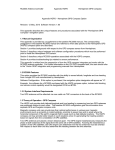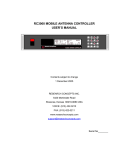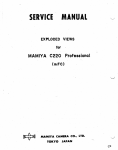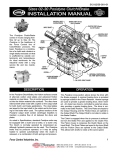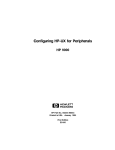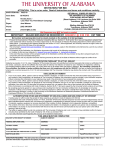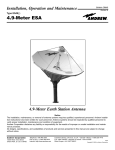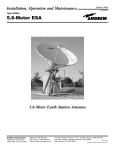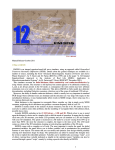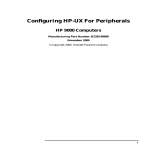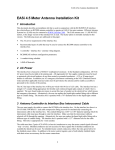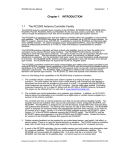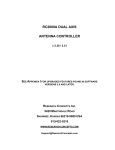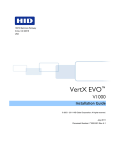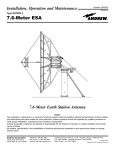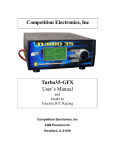Download RESEARCH CONCEPTS RC3000 Specifications
Transcript
RC3000/RC3050 INTERFACE SPECIFICATIONS Research Concepts, Inc. Shawnee, KS 66218-9680 USA phone: (913) 422-0210 fax: (913) 422-0211 www.researchconcepts.com email: [email protected] Overview The RC3000 Satellite Locator and RC3050 3-Axis Jog Controller are antenna controllers designed for use with elevation over azimuth antennas on mobile satellite uplink vehicles (also referred to as satellite news vehicles - SNV's). The product has also been adapted for use on flyaway systems. These microprocessor based controllers are housed in 2U rack enclosures and interface directly with the antenna’s position sensors, limit switches and motors. The predecessor of these controllers was the popular RC8097 Satellite Locator. This document describes the interface of the RC3000 and RC3050 controllers to an antenna mount. The RC3050 features a 2x16 liquid crystal display (LCD) and an 8 key keypad. The RC3050 can be supplied with an optional hand-held remote control, (option RC3000HRC). The other option available for the RC3050 is auto-deploy and auto-stow (option RC3050ASD). The auto deploy feature of the RC3050 allows the user to initiate an auto move that will raise the antenna from the stow position to the vertical position. The auto stow feature automatically places the antenna in the stow configuration. The RC3000 calculates the antenna pointing solution given the vehicle latitude/longitude, vehicle heading, and satellite longitude. (The pointing solution is the azimuth and elevation angles required to align the antenna with the desired satellite). Once a pointing solution is available the controller can automatically position the antenna at the calculated azimuth and elevation position. If the received signal (L band) or an analog voltage proportional to received signal strength is available the controller will perform a search for the satellite. The RC3000 can obtain the vehicle heading from an optional flux gate compass (designated RC3000FG) and the vehicle latitude and longitude from an optional GPS navigation receiver (designated RC3000GPS). If the system does not include the optional flux gate and/or GPS sensors the user can manually enter this data into the controller. The controller also allows the user to store a number of preset vehicle locations and satellite longitude values. The RC3000CRC option adds support for RS-232 or RS-422 based serial communications using the SA Bus protocol. The RC3000TRK option allows the RC3000 antenna controller to track inclined orbit satellites via step track and memory track algorithms (the antenna must be fitted with azimuth and elevation type pulse position encoders for inclined oribt tracking). The RC3000 also supports the RC3000HRC hand-held remote control. Controller Types The RC3000/RC3050 are currently available in two versions. Models with the ‘A’ suffix are designed for use with antennas powered by low voltage (12 to 36 volts), high current (up to 12 amps) azimuth, elevation, and polarization DC motors. Models with the ‘B’ suffix are designed for use with 90 volt (3/4 horsepower max) or 180 volt (1 ½ horsepower max) DC azimuth and elevation motors (1 horsepower max) and 12 volt DC polarization control motors (400 ma max). Schematics Schematics that describe the controller’s motor, limit switch, position sensor, and accessory connections are included in the appendix of this document. Physical Characteristics The RC3000 is designed for rack mounting. The dimensions are 19" x 3.5" x 17.5" (width x height x depth). The weight of the RC3000A is 19 lbs. The RC3000B weighs 13lbs. The liquid crystal display (LCD) used with the unit is designed for viewing from a 6 o'clock position. This means that the controller should be mounted above the operator’s eye level. An LCD module optimized for a 12 o'clock viewing is also available. The RC3000 enclosure is a standard rack mount chassis that occupies two rack units (2U). The controller is attached to the panel via four (4) 10-32 screws. The distribution of weight within the controller requires that additional supports be provided on either the back or sides of the controller enclosure. There are mounting points on the back and sides of the unit that can accept 10-32 screws for securing the controller to these support structures. Note that the mounting points on the back of the unit can also be used to attach cable strain relief straps. Locations of the additional enclosure mounting points is detailed in the appendices of this document. The RC3000 must be supported from the rear. Caution: RCI’s warranty does not cover damage to the controller due to inadequate support of the controller’s enclosure. Cabling and Connectors The only cables supplied with the unit are the AC line cord and the cables for the optional electronic compass and the GPS receiver. All other cables must be supplied by the customer. A kit is available that contains all mating connectors. The kit part number is FP-RC3K-CN-SET. Note that the cable service loop at the back of the controller should be long enough to allow the unit to be pulled out of its mounting rack with the cabling attached to perform internal adjustments. Also note that the controller’s J1, J3, J6, J7, and J10 connectors are identical to those on the back of the RC8097 controller. A back panel diagram is included in the appendix of this document. The following table describes the connectors on the back of the RC3000. Designation Type Function J1 DB15 female az/el/pol position sense J2 DB15 female AGC port (RC3000TRK) J3 DB15 female limit switches J4 DB15 male Pulse sensor input (RC3000TRK) J5 DB9 female Serial Comm. Port (RC3000CRC J6 IEC fused Power Entry J7 Amphenol 22-20S az/el/pol motors J8 Amphenol 126-221 HPA disable and accessories J9-GPS DB9 female on dongle GPS & cable, (RC3000GPS) J9-FG DB9 female on dongle FG Compass & cable (RC3000FG) J10 DB25 female Handheld Remote Control (RC3000HRC) J11 F female Block LNB signal for auto peak The following table lists the types of cable employed in the cabling kits produced by RCI. Cable Type Cable Configuration Controller Wiring Harness Circuit Alpha 2432C 2 x 16 AWG shielded with bare drain wire Az/El/Pol Motors Belden 9770 3 x 22 AWG shielded with bare drain wire Az/Pol Potentiometer and Single Phase pulse position encoders. Alpha 2404C 4 x 22 AWG shielded with bare drain wire Elevation Inclinometer and Limit Switches (containing two limit switch circuits, i.e. elevation up and elevation down) Alpha 1292C 2 x 22 AWG shielded with bare drain wire Limit Switches Power Entry Connector J6 accepts an IEC type AC power plug. RC3000 controllers can be configured at the factory for either 115 or 230 VAC operation. The AC line cord supplied with the controller is appropriate for the controller’s AC power configuration. The controller’s AC line voltage configuration can be determined by viewing the window on the power entry module. The window will either display ‘115’ or ‘230’. The RC3000A can be configured by the user in the field for operation at either 115 or 230 VAC line voltage. Use the following procedure to re-configure the RC3000A’s AC power configuration … 1. Switch off the controller. 2. Remove the IEC power cord from the back panel entry module. 3. With a small, straight bladed screw driver remove the fuse drawer and the fuse from the power entry module. 4. Use a pair of needle nose pliers to remove the card (the end of the card is labeled either ‘115’ or ‘230’) from the power entry module. Rotate the card and insert it into the power entry module so that the desired line voltage is displayed. 5. Replace the fuse and fuse drawer. Use a slow blow fuse that is appropriate for the line voltage selected: 8 amp for 115 VAC, 4 amps for 230 VAC. The RC3000B can be configured at the factory for either 115 or 230 VAC operation. The RC3000B’s line voltage setting cannot modified by the user in the field. The RC3000B uses the same power entry module as the RC3000A. With the RC3000B, the card inside the power entry module is glued into position. The card indicates the correct voltage but the voltage cannot be changed by the user in the field. The AC line fuses appropriate for the RC3000B are 12 amp, slow blow for 115 VAC operation and 6 amp, slow blow, for 230 VAC operation. RC3000A Az/El/Pol Motor Drive The RC3000A is designed to drive 12 to 36 volt DC azimuth, elevation, and polarization motors. The absolute maximum allowed motor current is 12 Amps. The RC3000A employs a built-in, solid-state motor controller (model 25A8 from Advanced Motion Controls – ph: (805 389-1935). The motor drive module supports IR compensation, current limiting, dual speed operation, and dynamic braking. The drive train is also protected with resettable fuses. Please specify the maximum current for each axis. For motors with values of L_eff (effective inductance) less than 200 uH, additional inductance must be added in series with the motors to insure proper operation of the motor drive. These additional inductors can be placed inside the controller at the factory. When ordering an RC3000A specify L_eff for each motor. The 3000B is designed to drive 90 volt (3/4 horsepower max) or 180 volt (1.5 horsepower max) DC azimuth and elevation motors. Ideally, 90 volt DC motors would be specified with 115 VAC input power and 180 volt DC motors with 230 VAC input power. 180 volt motors cannot be used with 115 VAC input power. The motor drive in the RC3000B is the model KBPB by KB Electronics (ph: 800 221 6570). This motor drive supports IR compensation, current limiting, dual speed operation, and dynamic braking. The polarization drive of the RC3000B is designed to power a 12 volt DC motor which draws less than 400 ma. Motor drive current is supplied via an MS3102A22-20S type circular connector (designated J7). Shielded cables (shield connected only at the controller) should be used to interface the motors to the controller. A schematic detailing the motor connections is included in the appendix. The following table describes the polarity of the RC3000’s motor drive output signals. Axis RC3000 Connector J7 Terminals Polarity Azimuth G, F For azimuth CW movement, terminal G has the higher potential. Elevation H, J For elevation UP movement, terminal H has the higher potential. Polarization A, B For polarization CW movement, terminal A has the higher potential. Analog Position Sensors RC3000/RC3050 controllers are designed to interface to 1K ohm or 5K ohm potentiometer type azimuth and polarization position sensors and an inclinometer type elevation position sensor. The RC3000 employs a 10 bit A/D (analog to digital) converter to sense azimuth and polarization positions. Azimuth (polarization) position resolution can be calculated by dividing the total azimuth (polarization) travel by 983. For example, a +90° azimuth movement mount has 180° total azimuth travel, 180 degrees B 983 gives 0.18° azimuth resolution. The azimuth (polarization) position sense potentiometer can be connected either directly to the azimuth (polarization) axis or driven by gears. If the azimuth potentiometer is attached directly to the azimuth axis pivot point a potentiometer with a linearity specification of 0.25% (or better) should be employed. Multi-turn potentiometers manufactured by Contelec (PD22xx series) have performed well in satellite antenna applications. In the US, Contelec potentiometers are distributed by Novotechnik, ph: 508 485-2244. Component values in the controller must be tailored to properly match the azimuth and polarization potentiometers to the mount’s range of azimuth and polarization movement. When ordering an RC3000 or RC3050, please specify the following for both the azimuth and polarization axis … Quantity Units Example Value Total range of antenna movement about the axis. Degrees +/- 155 degrees of azimuth movement Total number of potentiometer turns. Whole turns and degrees. 10 turns, tolerance: + 0 degrees, - 10 degrees Ratio of movement about the antenna axis to potentiometer movement A ratio, 1:x (x greater than 1) If 310 degrees of azimuth movement results in 5.6 turns of the azimuth potentiometer the ratio is 1:x, where x equals (5.6 x 360) / 310 or 1:6.503. The directional sense of azimuth movement is defined as clockwise (CW) or counter-clockwise (CCW) as viewed by an observer located above the antenna. On the controller CW movement results in a greater sensed azimuth position. The directional sense of polarization movement is also defined as CW or CCW as seen by an observer standing behind the antenna reflector looking ‘through’ the reflector at the satellite. The reference position for the polarization position angle is vertical polarization for a satellite located at the same longitude as the antenna. In the northern hemisphere, for vertically polarized satellites to the west of the antenna, the polarization deflection is defined as CW relative to the reference position. In the northern hemisphere, the polarization angle increases for satellites farther to the west. In some modes of operation the controller predicts the polarization value required to align the antenna with a given satellite’s horizontal or vertical polarization position. For this feature to function properly the antenna’s polarization directional sense characteristics (defined by the polarization motor and position sensor) must be consistent with that of the controller. The elevation position sense circuit of the RC3000 is designed to interface to the Lucas/Schaevitz AccuStar model 0211 1002-000 or 0211 1102-000 inclinometers (abbreviated data sheet included in the appendix). The inclinometer’s position reference is marked on the body of the inclinometer. The inclinometer should be mounted such that the body of the inclinometer is rotated CW (as viewed by an observer looking at the front of the inclinometer) as the antenna’s elevation angle increases. The inclinometer must also be oriented properly on the antenna mount. To describe the orientation of the inclinometer, the term ‘elevation offset angle’ needs to be defined. Elevation offset angle is defined as the antenna’s RF elevation pointing angle (relative to horizontal) when a straight edge oriented vertically across the face of the antenna reflector (reflector top to bottom) is plumb. The inclinometer should be oriented so that when the antenna reflector is plumb the reference mark is deflected CCW (from the vertical position) by an amount equal to the 35 degrees minus the ‘elevation offset angle’. If the inclinometer is attached as described the sensor will operate in its most accurate region for elevation look angles up to 80 degrees. A paper entitled ‘RC3000 Inclinometer Orientation’ describes the inclinometer orientation in more detail. The inclinometer mounting flange allows for some adjustment of the device’s rotational orientation. The mounting position selected for the inclinometer should allow for adjustment of the inclinometer’s orientation. The inclinometer should be mounted in a location such that it is protected somewhat from blowing rain. Connector J1 (DB-15 Female) interfaces the position sensors to the controller. The cables used to interface the controller to the position sensor should be shielded and the shields should be connected only at the controller end of the cable assembly. A schematic showing the sensor connections is given in the appendices. Limit Switches The RC3000 supports azimuth stow, elevation stow, elevation up, and elevation down limit switches. Azimuth cw/ccw and polarization cw/ccw limit indications are derived from the azimuth and polarization position sense voltages produced by the potentiometers. If failsafe limits are required for the azimuth and polarization axis they can be implemented with limit switches and steering diodes. Contact the factory for more information. If the azimuth stow limit is not active, the antenna can only be moved in elevation between the down limit and up limit. If the azimuth stow limit is active, the antenna may be moved in elevation between the elevation stow limit and the elevation up limit. When the antenna is below the elevation down limit the antenna may not be moved in azimuth or polarization. The RC3000 optionally supports another limit switch that may be used to indicate polarization stow or antenna deploy status. The RC3000 does not support polarization limit switches. The user may provide these externally using micro switches and steering diodes if needed. The following table describes the limit switch logic … Limit Switch Limit Switch Contact Configuration When Antenna Is AT The Limit Azimuth Stow Closed Elevation Stow Open Limit Switch Limit Switch Contact Configuration When Antenna Is AT The Limit Elevation Up Open Elevation Down Open Flux Gate Placement The RC3000 antenna controller can obtain the vehicle’s heading from the optional flux gate compass (RC3000FG). A diagram of the flux gate is included in the addendum (an unhoused version of the flux gate is also available). The flux gate senses the direction of the earth's magnetic field. To ensure the greatest accuracy, the flux gate should be mounted in a location that is free of magnetic fields and away from ferrous metals. Devices which generate magnetic fields include electric motors, high power microwave amplifiers, microwave circulators and isolators, and power supplies. Note that current flowing through a conductor generates a magnetic field – the strength of the magnetic field is proportional to the magnitude of the current and inversely proportional to the distance from the conductor. Ferrous metals located on the vehicle distort the earth’s magnetic field. For a vehicle, the distortion of the earth’s magnetic field is generally such that the earth’s magnetic lines of flux tend to align themselves with the vehicle’s long axis. The flux gate supports calibration routines that can partially compensate for the distortion of the earth’s magnetic field due to ferrous metal in the vehicle itself and magnetic fields generated by equipment located on the vehicle. Generally, the best performance is achieved when the flux gate is mounted as high as possible on the vehicle. The RC3000 can support placement of the flux gate on the antenna reflector. When mounted in this manner, the antenna must be raised to a ‘deploy’ position before the vehicle heading can be obtained. If the flux gate is to be placed on the roof of the vehicle (as opposed to the back of the antenna reflector), a common wet compass may be used to help find the best location on the vehicle for the flux gate. To make the measurement it is generally best if the vehicle is pointed in either a westerly or easterly direction. With the wet compass the user should stand on the roof of the vehicle and slowly lower the compass down to the proposed flux gate mounting location. If the needle of the compass experiences deviations as it is lowered to the proposed mounting location it indicates that there are either external magnetic fields or concentrations of ferrous metals in the vicinity of the proposed flux gate mounting location. The flux gate should be placed in the location on the roof of the vehicle where the compass experiences the least deviation. When using the wet compass to determine flux gate placement be sure that all equipment which may be in operation when the flux gate is used is turned on. The GPS and Flux Gate Compass interface to the RC3000 via a DB-37 female connector (J9). A DB-37 male to two DB-9 (female) ‘Y’ cable provides an interface to the GPS and Flux Gate interface cables. The flux gate cable should be routed as far as possible from electrically noisy devices and unshielded cables. GPS Receiver Placement The RC3000 can interface with an optional GPS receiver (designated RC3000GPS). The GPS receiver (with built-in antenna) is housed in a weather proof assembly which must be placed on the roof of the vehicle so that the receiver has a clear view of the sky when the antenna is stowed. See the addendum of this document for additional GPS mounting information. The GPS and Flux Gate Compass interface to the RC3000 via a DB-37 female connector (J9). A DB-37 male to two DB-9 (female) ‘Y’ cable provides an interface to the GPS and Flux Gate interface cables. The GPS cable should be routed as far as possible from electrically noisy devices and unshielded cables. L Band Input The RC3000 J11 (F type) connector accepts an L band signal from a satellite block down converter (950 to 1450 MHz, -50 to –5 dBm). The controller’s L band input circuit provides a DC output voltage that is proportional to the power level of the L band signal to the controller’s microprocessor. Note that there is a DC block (capacator) in series with the L band input. The RC3000 can use the L band signal to perform an AutoPeak function (the analog signal strength inputs can also provide signal strength information for the AutoPeak function). During an AutoPeak the controller performs a search. If a signal is found the controller peaks the antenna on that signal. For a geostationary satellite the controller performs a line search in azimuth (the elevation is periodically adjusted to nominal value if the platform is not level). For an inclined orbit satellite, the controller performs a spiral search. Analog Signal Strength Input The RC3000 can accept 2 analog input voltages that are proportional to received signal strength via the J2 connector. Signal strength information is required for inclined orbit satellite tracking and can optionally provide a source of signal strength information for the AutoPeak function (see the section on ‘L Band Input’ section above). The range of analog voltages accepted by the RC3000 is –15 VDC to + 15 VDC. The analog voltages can be generated either by a beacon receiver or by an AGC (Automatic Gain Control) circuit in a modem or analog receiver. The RC3000 can accept signal strength inputs of either polarity. In this context positive polarity means that the output voltage increases as the received satellite signal increases. Negative polarity refers to the case where the output voltage decreases as the satellite signal increases. To minimize noise pickup, a shielded cable (with two conductors) such as Alpha 1292C should be used to connect the source of the signal strength output to the RC3000. Note that the cable shield should be open at either the RC3000 or at the source of the signal. Associated with each analog input is a gain and offset potentiometer. These pots level shift and either expand or reduce the analog input’s dynamic range to match the controller’s A/D conversion range (0 to 5 volts). The offset potentiometers generate a pair of offset voltages that determines the level shift applied to each of the signal strength inputs. These offset voltages are available on connector J2 to facilitate adjustment of the gain and offset potentiometers. Accessory Connector Connector J8 (9 conductor – Amphenol 126-221 type) provides access to the following circuits … 1. HPA (High Power Amplifier) Disable is a form C contact arrangement with normally open, common, and normally closed contacts. When the antenna is below the down elevation limit or the antenna is performing any large-scale auto-moves such as deploy, locate, or stow, the normally-open and common pins will be connected. For antenna’s that employ electro-mechanical brakes the HPA disable feature is not enabled. Please contact the factory for details. 2. Alarm Out is a normally closed relay. These contacts will be closed whenever the controller is powered down or an alarm condition has been detected. For antenna’s that employ electro-mechanical brakes the Alarm Out feature is disabled. Please contact the factory for details. 3. GPS 1 Pulse per Second Output is a TTL square wave output (referenced to the chassis ground connection). This output is only available if the controller is equipped with a Garmin model 36 GPS receiver. Note that the RC3000GPS option does not include the Garmin model 36 receiver. Contact the factory for availability of the model 36 receiver. 4. GPS Instant On Feature – The GPS Instant On feature is realized by powering the GPS receiver while the vehicle is in motion. This allows the receiver to lock to the GPS satellite signals while it is in transit. The vehicle latitude/longitude (lat/lon) will be available as soon as the vehicle reaches the uplink location. Without the Instant On feature, after power up the GPS requires 2 to 4 minutes to determine vehicle lat/lon. With the Instant On feature, the controller applies vehicle power to the GPS whenever the vehicle ignition system is energized and for approximately 30 minutes after the vehicle’s ignition system is de-energized. The GPS Instant On feature requires a direct connection to the vehicle +12V battery, a connection to the +12V vehicle accessory voltage (+12V on while the vehicle ignition system is on), and a connection to the vehicle’s chassis ground. When the GPS Instant On feature is active, power is routed to ports 1, 3, and 4 of the navigation sensor connector, J9. To enable the Instant On feature, diodes D31 and D29 must be installed on the RC3000 feature board. Support for electro-mechanical brakes on the azimuth and elevation axis can be provided via the J8 connector. This port can also provide access to an unregulated power supply or other user specified features. Please contact the factory for more information. The following table shows the pin connections for J8 on the RC3000. J8 Pin # Description A HPA Disable, normally-open, 3A @ 30VDC max or 3A @ 250VAC max B +12 - +14V Vehicle Battery input (OR +Vunreg. for auxiliary output models, 2A max) C Ground, Vehicle chassis ground input. D HPA Disable, common, 3A @ 30VDC max or 3A @ 250VAC max E HPA Disable, normally-closed, 3A @ 30VDC max or 3A @ 250VAC max F Alarm common, 3A @ 30VDC max or 3A @ 250VAC max G Alarm normally-closed, 3A @ 30VDC max or 3A @ 250VAC max H +12 to +14V Vehicle accessory input (Vunreg. Return for auxiliary output models) I 1PPS output, TTL compatible Hand Held Remote Connector J10 (DB-25 female) provides an interface to the optional hand-held remote control (designated RC3000HRC). The RC3000HRC option allows an operator to jog the antenna and view antenna limit indications. Antenna position information is not displayed on the hand-held remote. The remote is housed in a 3” x 6” x 1.75” aluminum chassis and interfaces to the RC3000 via a 25’ multi-conductor cable (included with the handheld remote). Pulse Sensors for Inclined Orbit Satellite Tracking Applications The RC3000 supports interfaces to analog position sensors (azimuth potentiometer, elevation inclinometer, polarization potentiometer). The analog sensors provide good absolute position accuracy and are used for open loop antenna pointing. The analog sensors, however, do not provide the resolution needed for inclined orbit satellite tracking. The RC3000TRK option allows the RC3000 to track inclined orbit satellites using step track and memory track algorithms. For inclined orbit satellite tracking, the antenna mount must be equipped with azimuth and elevation pulse type position encoders (in addition to the analog position sensors). The output of a pulse encoder is a voltage waveform that transitions between two levels (‘high’ and ‘low’) as the encoder shaft is rotated. There are two types of pulse encoders: single phase and quadrature. A single phase pulse encoder produces a single channel pulse output. By looking at the output of a single phase encoder an antenna controller cannot determine which way the shaft of the encoder is being rotated. The controller has to increment or decrement the position count for that axis by knowing which way the antenna is commanded to move. If pulses occur when the antenna is not commanded to move (or is not in the coast interval immediately following a move), the controller does not know whether to increment or decrement the position count. For this reason, single phase pulse encoders can only be used reliably when they are placed at a point in the antenna drive train that does not experience backdrive. In this context, backdrive refers to forces applied to the antenna reflector that cause the shaft of the encoder to rotate. In a typical RC3000 inclined orbit tracking application, single phase Hall effect pulse sensors are placed on the az/el drive motor shafts and the pulse encoders essentially count motor revolutions. A typical gear ratio for a mobile antenna mount (motor revolutions to antenna revolutions) is 5000:1 or greater. Backdrive is typically not a problem when the sensors are directly attached to the antenna az/el drive motors. The Powermation Digital Tachometer is a single phase pulse encoder designed for use on 56C type motor mounting flanges. The Powermation unit has been used successfully for inclined orbit tracking with the RC3000. A datasheet describing the Powermation sensor is included with this document. A quadrature pulse sensor produces two channels of pulse information as the encoder shaft is rotated. One channel is offset 90 degrees from the other when the input shaft of the sensor is turning in a given direction. With a quadrature sensor it is possible to determine which way the sensor shaft is turning by looking at the phase relationship between the two output pulse waveforms. This characteristic allows quadrature sensors to be attached directly to the antenna mount’s az/el pivot points – as the antenna blows around in the wind the outputs from the quadrature pulse encoder are properly accumulated by the antenna controller. Quadrature pulse encoders are usually equipped with a third channel that produces an index pulse. The index pulse is active only when the sensor shaft is at a reference position. The index channel can be used by a controller to initialize the controller’s internal pulse position count. At the present time the RC3000 does not support quadrature type pulse encoders. The controller can interface to single phase pulse position encoders whose power supply requirements are compatible with 5.7 volts DC (200 milliamps max). Note that other pulse position encoder power supply voltages are available, please contact the factory for details). The RC3000 controller counts both the rising and falling edges of the pulse output waveform (i.e. each pulse provides two position counts). The position count is decremented for azimuth ccw (elevation down) movement and incremented for azimuth cw (elevation up) movement. The waveform's high level amplitude should be 4.5 volts or greater and the waveform’s low level amplitude should be less than 0.5 volts. The waveform's minimum high or low pulse duration should be at least 10 milliseconds. This means that pulses less than 10 milliseconds in duration may not be detected by the antenna controller. The controller can accumulate a maximum of 65000 pulses about either the azimuth or elevation axis. Note that for single phase pulse sensors that count motor revolutions (such as the Powermation unit), a one pulse per revolution sensor characteristic is almost always appropriate. Shielded cables equipped with a bare drain wire that provides a connection to the shield must be employed to interface the controller to the position encoders. The drain wire must be connected at the controller to the AZ PULSE SHEILD and EL PULSE SHIELD terminals provided on the J4 connector. The drain wire and shield must not be allowed to come in contact with earth ground or the vehicle chassis. Use heatshrink at the sensor to prevent the frayed ends of the shield or drain wire from making contact with the sensor body or connector. If the drain wire is allowed to come in contact with earth ground a ground loop will be formed (the controller SHIELD terminals are connected to the vehicle chassis). With a ground loop current flowing in the earth ground plane or vehicle chassis can flow through the sensor shield and cause stray counts to be induced in the controller’s pulse input circuits. If the sensor cable is spliced be sure to splice the drain wire and insulate the connection to prevent a ground loop. RS232/RS422 Serial Communications J5 allows for PC remote control of the RC3000. The RC3000 may be internally configured to communicate using either RS232 or RS-422 electrical levels. The communications protocol is derived from the SA Bus standard. Please see the white paper entitled ‘Computer Control of Satellite Antennas’ for more information on the communications protocol. Schematics P1, P2, P3, P4, P5, P7, P9, P10, Back Panel Addendum Flux Gate (1 page), AccuStar Clinometer (1 page with dimensions), GPS (1 page), Inclinometer Orientation (1 page), Powermation Sensor (1 page), RC3000 Rear Chassis Supports (1 page) P2 - Analog Signal Strength P1 - Position Sensors DB15 male 10 AZ Drain 9 AZ + 1 AZ Wiper 2 AZ - 3 POL Drain 11 POL + 4 POL Wiper 12 POL - 7 El Drain 6 El +15 14 El Com 8 El -15 15 El Signal DB15 male 8 Azimuth Position Pot. AGC 1 Input Receiver 7 Polarization Position Pot. Elevation Inclinometer AGC Return 15 AGC 2 Input 5 Shield 14 V_Offset 1 10 Offset Return 13 V_Offset 2 1 Digital I/O 0 2 Digital I/O 1 3 Digital I/O 2 4 Digital I/O 3 Receiver 6 +5 VDC (200 mA. max) 9 +24 VDC Unregulated (1 A. max.) 11 -15 VDC Regulated (40 mA. max.) 12 +15 VDC Regulated (40 mA. max.) P3 - Limit Switches DB15 male 9 AZ Stow + 7 AZ Stow - 10 EL Up + 14 EL Up - 5 EL Down + 6 EL Down - 11 EL Stow + 13 EL Stow - 2 Pol Stow + 1 Pol Stow - 4 Drain NC LIMIT SWITCHES Azimuth Stow NO Elevation Up NO Switch Annotations are for the Limit Condition Elevation Down P7 - Az/El/Pol Motors NO Elevation Stow NO Polarization Stow Amphenol 22-20P E AZ Drain G Az Drive F Az Return D El Drain H El Drive DC MOTORS AZIM ELEV J El Return C Pol Drain A Pol Drive POL B Pol Return P9 - GPS & Flux Gate Compass P4 - Pulse Sensor DB37 male DB15 female 2 AZ Pulse In 1 AZ Pulse Return 10 AZ Pulse Power * 9 AZ Pulse Shield 4 AZ Quad Pulse 3 AZ Quad Return 11 AZ Quad Power * 7 EL Pulse In 8 EL Pulse Return 14 EL Pulse Power * 15 EL Pulse Shield 5 EL Quad Pulse 6 EL Quad Return 13 EL Quad Power * 12 Alarm In Azimuth Pulse Sensor For Future Support of Quadrature Sensor Elevation Pulse Sensor For Future Support of Quadrature Sensor DB9 male 1 20 2 21 3 22 4 23 5 P1-Vaux N/C P1-RX1 P1-TX2 P1-TX1 P1-GND (N/C) P1-Vpwr P1-RX2 P1-GND 1 6 2 7 3 8 4 9 5 24 6 25 7 26 8 27 9 28 P2-GND N/C P2-Vpwr P2-GND (N/C) P2-TX1 N/C P2-RX1 N/C P2-Vaux 5 9 4 8 3 7 2 6 1 Yellow Gray White Green Blue N/C Red Purple Black GPS Receiver TXD1 RXD1 Vin GND GND Fluxgate Compass (Housed) Vin GND RS232 IN RS232 OUT DB9 male P10 - Hand Held Remote Control DB25 male P5 - RS232/RS422 I/O 1 2 DB9 male 2 RXD 3 TXD 5 GND PC Serial Port RS-232 Wiring DB9 male 3 TXD 9 TXD/ 4 RXD 6 RXD/ RS-422 Wiring RS-422 BUS 3 14 4 17 5 15 6 19 7 20 8 21 9 22 16 23 11 24 12 25 13 Black w/ White Stripe Red w/ Black Stripe Orange w/ Black Stripe Black w/ Red Stripe Orange w/ Red Stripe Blue w/ Red Stripe Red w/ White Stripe Blue w/ White Stripe Green w/ White Stripe Green Orange Red Blue w/ Black Stripe White Green w/ Black Stripe Blue White w/ Red Stripe Black w/ Red & White Stripe Green w/ Black & White Stripe Red w/ Green Stripe White w/ Red & Black Stripe Orange w/ Green Stripe Red w/ White & Black Stripe (Optional) Remote Accessories RF Auto F Peak O S 2 G N 2 O S 1 Signal Strength Pulse Sensors Navigation Sensors DB-15 F DB-15 M DB-37 F J2 - AGC J4 - Pulses J9 - Navigation G N 1 J1 - Sensors J3 - Limits J5 - Comms. J10 - Handheld J12 - Waveguide DB-15 F DB-15 F DB-9 F DB-25 F DB-15 F Drive Sensor Limit Switches PC Remote Handheld Remote Wavguide Switch 10-32 threaded insert J8 - Acc. 10-32 threaded insert J7 Motor Drive J6 Power Entry Fuse Motors - J7 10-32 threaded insert RC3000 FLUXGATE COMPASS Research Concepts, Inc. Fax: (913) 422-0211 • • • • • 5420 Martindale, Shawnee, KS 66218-9680 e-mail:[email protected] Phone: (913) 422-0210 www.researchconcepts.com This sensor will operate through tilt (pitch & roll) ranges of +16o. Cable 25’, 1/4” diameter, terminated with a D9 male connector A 1.25” x .625” opening is required for the connector to pass through a panel. An unhoused model is also available. Environmental Specifications • Operating Temperature: -40oC to +65oC • Storage Temperature: -57oC to +71oC What you need to know to order. AccuStar Electronic Clinometer Model Number Description 0211 1002-000 0211 1102-000 Analog Vertical Flange Horizontal Flange Lucas Control Systems 1000 Lucas Way Hampton, VA 23666 Phone: (757) 766-1500 Fax: (757) 766-4458 Internet: www.schaevitz Analog Output Features √ √ Internally regulated Bipolar input/output The Analog clinometer is a signal conditioned sensor which has been designed for dc voltage, bipolar operation. The clinometer requires a bipolar supply of ±8 to ±15 VDC and delivers an output of ±3.6 VDC. This device is internally regulated for various applications. The output scale is fixed at a nominal 60mV per degree not dependent on the supply voltage. The Analog clinometer has full EMI and ESD suppression circuitry on every line. Analog Electrical Specifications Voltage Voltage Supply Nominal Range (regulated) Current Scale Factor Load Resistance (min.) Level Output (0°) ±12 VDC ±8 to ±15 VDC 5 mA/supply 60 mV/degree ±10% 10 k0hms 0 VDC Electrical Connections Wire Source Black Power ground Red +8 to +15 VDC Gray -8 to -15 VDC Blue Signal output (reference to power ground) RC3000 GPS RECEIVER MOUNTING Research Concepts, Inc. Fax: (913) 422-0211 5420 Martindale, Shawnee, KS 66218-9680 e-mail:[email protected] Phone: (913) 422-0210 www.researchconcepts.com BASIC MOUNT MARINE MOUNT A marine mount is a 1” diameter rod with 14 TPI (Thread Per Inch), non tapered. Will work with 3/4” NPT (National Pipe Thread). 3.80” 2.25” FLANGE MOUNT 2.86” 1.5 7” 0” 2.5 Operating Temp. -30oC to +85oC Storage Temp. -40oC to +90oC 2.50” Cables 25’, 1/4” diameter A 1.25” x .625” opening is required for the connector to pass through a panel. VERTICAL REFERENCE INCLINOMETER REFERENCE X = 35 DEGREES - ANTENNA OFFSET X ELECTRICAL BORESIGHT INCLINOMETER ANTENNA OFFSET HORIZONTAL REFERENCE FEED REFLECTOR BACKSTRUCTURE RC3000 INCLINOMETER ORIENTATION DIGITAL TACHOMETER SENSOR KITS POWER/MATION W238 N1690 Rockwood Drive Waukesha, WI 53188 Phone: (414) 523-0600 800-242-2060 Fax: (414) 523-0611 SPECIFICATIONS INPUT: 5-16 VDC OUTPUT: NPN, 20ma TEMPERATURE: Minus 400F to plus 2250F OUTPUT CONNECTION: Three Wire PULSES PER REVOLUTION (ppr): 1 * WAVE FORM: Square Wave ENVIRONMENT: Impervious to dust, oil & water * 2, 15 & 60 ppr models are available ORDERING CHART DIMENSIONS MOTOR FRAME SIZE KIT MODEL NUMBER A B C D 56C DTK-056 M1 9.375 5.875 4.500 7.875 143TC, 145TC, 182C DTK-184 M1 9.375 5.875 4.500 7.875 & 184C 182TC, 184TC, 213C, DTK-215 M1 12.312 7.250 8.500 10.000 215C & 254C 213TC, 215TC, DTK-254 M1 12.312 7.250 8.500 10.000 254UC & 256UC 254TC & 256TC DTK-256 M1 12.312 7.250 8.500 10.000 NOTE: Kits consist of motor face ring, sensor, mounting bolts and sensing wheel. E 5/8” 7/8” 1-1/8” 1-3/8” 1-5/8” NOTE: To interface sensor to controller, use a shielded triple (18-22 AWG) with bare drain wire, such as Belden 8772. RESEARCH CONCEPTS, INC. 5420 Martindale, Shawnee, KS 66218-9680 www.researchconcepts.com Phone: (913) 422-0210 The RC3000 is housed in a standard 2 RU enclosure 17 inches long and 17 inches wide. Handles extend approximately 1.5" in front and connectors with the mating connectors will extend approximately 3.5" in the rear. Four #10-32 threaded inserts are positioned to the rear on each side for chassis support. These holes lie in a 2.5" x 6.0" rectangle. 2.95 0.45 0.00 10.50 16.50 0.00 17.05

















